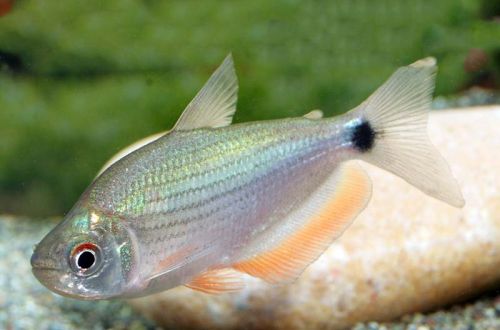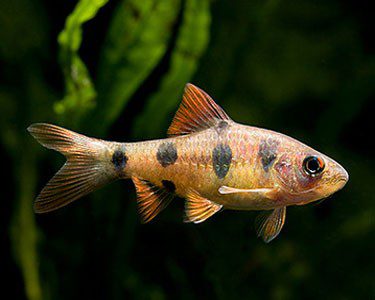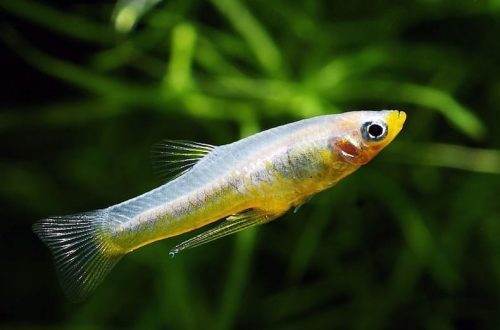
Tetra-penguin
Thayeria crooked or Tetra penguin, scientific name Thayeria boehlkei, belongs to the Characidae family. Bright, mobile, dynamic and peaceful fish. Unpretentious, hardy, easy to breed, perfectly adapt to a wide variety of conditions, so they can complement almost any freshwater tropical aquarium. May be recommended for beginner aquarists.
Contents
Habitat
Originally from South America from the territory of modern Brazil. One of the numerous populations is found in the Araguay River basin, one of the largest rivers on this continent. They live in various natural environments, both in small streams and rivers with clear running water, and in swamps with dense lush vegetation.
Brief information:
- The volume of the aquarium – from 70 liters.
- Temperature – 22-29°C
- Value pH — 5.5–8.0
- Water hardness – soft to medium hard (3-20 dGH)
- Substrate type – any soft dark
- Lighting – subdued
- Brackish water – no
- Water movement – weak or still water
- The size of the fish is up to 7 cm.
- Meals – any
- Temperament – peaceful, active
- Keeping in a flock of 6 individuals
Description
In English terminology, this species is often found under the name “hockey stick” because of the wide dark horizontal stripe that stretches all over the body and ends at the tail with a bend. This line is shaped like a hockey stick. And the name “penguin”, as it is believed, did not come from the white and black colors, but from the name of one of the most titled hockey teams, the Pittsburgh Penguins, which plays in the NHL.
Food
In the home aquarium, it accepts all types of dry, frozen and live food, it is recommended to combine them in the daily diet. It is undesirable to get carried away with only one type of food, this can lead to a weakening of the tone of the fish, sluggish behavior and loss of color brightness.
Maintenance and care, arrangement of the aquarium
Taeria crooked is highly adaptable to a variety of conditions over a wide range of pH and dGH values. One of the few conditions for successful maintenance is subdued lighting and a weak flow of water, or its complete absence.
The design of the aquarium can be anything, but the fish look most natural in an environment close to their natural range. For the river type, twisted roots, tree branches, fragments of smooth rocks and stones with some floating and rooting plants, a dark sandy substrate can be used as decoration.
For an aquarium imitating a swampy section of the river, the same design elements are used with the addition of tree leaves, which, in the process of decomposition, saturate the water with tannins and also color it in a slightly brown color. Oak leaves are great for this purpose. Before placing them on the bottom, the leaves are first dried and then soaked until they begin to sink. Another important element is peat, which is present in all swamps. It is used in filtration systems, or added directly to water, for example, in canvas bags. It’s important – buy peat only in professional pet stores, already processed.
Behavior and Compatibility
Peaceful and very active species, goes well with other active fish of similar size. The best option is to keep with representatives from South America, for example, various tetras (Tetra firefly, Red-nosed Tetra, Pink Tetra, Callista, Rhomboid and Lemon Tetra, etc.), catfish Corydoras or Mail catfish, Barbs and many others.
Breeding / breeding
It is quite simple to get offspring and this does not require the creation of any special conditions, spawning can also occur in a common aquarium, but in this case the survival rate will be at an extremely low level. They can become a victim of both other fish and their own parents. Therefore, if you plan to start breeding, we recommend using a separate tank – a spawning aquarium, where adult fish will be transplanted during the mating season.
A spawning aquarium usually has a volume of 20 liters or more. The decoration uses thickets of small-leaved plants or mosses, such as Java moss and Riccia floating, which are fixed at the bottom. They serve as reliable protection for eggs. Another effective way is to use a fine mesh grid placed over the substrate. The set of equipment is minimal – a simple sponge airlift filter and a heater. The lighting system can be neglected, the light coming from the room will be enough.
The incentive for the beginning of the mating season is the establishment of a temperature near the upper permissible mark and feeding mainly live or frozen food. After some time, some Tayerii will noticeably round up – these will be females filled with caviar.
The fish of both sexes are carefully transplanted, now it is necessary to wait for the start of spawning (it may take several days), at the end of it, the newly-born parents are returned back. The fry appear after 12–24 hours, and begin to swim freely on the 3rd day. Feed with microscopic food (sold in pet stores), or the so-called “live dust” – ciliates with shoes and Artemia nauplii.
Fish diseases
A balanced aquarium ecosystem with the right conditions is the best guarantee against disease. If signs of illness are found (unusual behavior, rashes on the body, etc.), first check the quality and parameters of the water and only then take it for treatment. Often it is enough to return the conditions of detention to optimal values in order to solve the problem.





